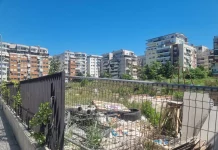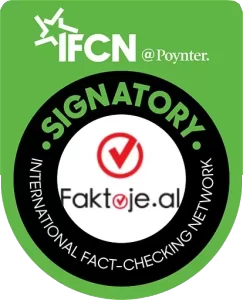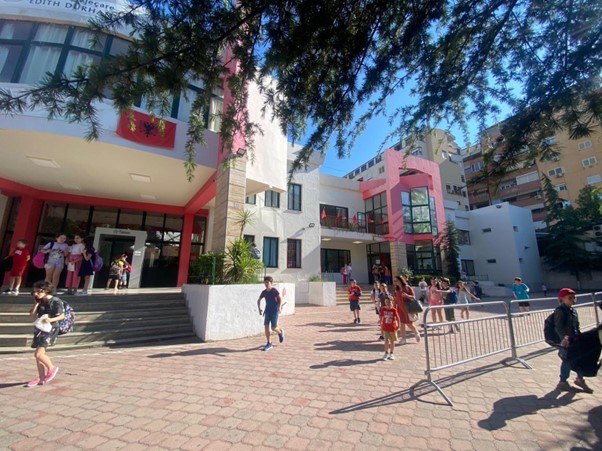Ilda Hoxha
Public transport continues to be a major issue in the capital, despite numerous promises made to enhance its quality. Mayor Erion Veliaj has repeatedly pledged, over the past eight years, various interventions that would transform the service. However, both citizens and experts assert that urban transport in the capital is in a state of ‘coma’.
In 2015, Erion Veliaj, the Mayor of Tirana, made a significant promise to transformation the city’s urban transport system. ‘The quality of urban transport will be the same in both Lapraka and Vaqarr,’ Veliaj declared in July 2015.
He reiterated this promise in December of the same year when transport companies sought to raise ticket prices.
‘First, we need to listen to whether they agree on implementing an electronic ticketing system, if they support new bus routes that also reach rural areas, and if they are willing to improve and enhance the quality of their services and vehicles. While some buses are acceptable, others are like ZIS’s (in a deplorable state)’, Veliaj pointed out at that time.
Enhancing urban transport has always been a priority in his pledges, as it directly impacts citizens who have voiced their dissatisfaction with the existing service quality.
‘In 2016, Tirana’s Mayor, Erion Veliaj, promised, ‘This year, we will implement the electronic ticket, which will effectively resolve some minor issues we are facing.’
The following year, in 2017, he announced that a significant obstacle had been overcome and reiterated that the introduction of electronic tickets for urban transport in the capital would begin. ‘The Council of Ministers has approved the decision that empowers the Municipality of Tirana to issue electronic tickets. This process has been lengthy; for 25 years, it was under the monopoly of the central government,’ he stated.
However, even after all these years, the electronic ticket has not yet been implemented in urban transport in the capital.
In 2017, Veliaj also remarked that the day when Tirana would offer nighttime public transport services was not far off. ‘It won’t be long before we provide 24-hour service, including during the night,’ he pledged. Yet, seven years later, Tirana still lacks this nighttime service. The urban transport operates from 5 a.m. until 10 or 11 p.m’.
In May 2019, Tirana’s Mayor, Erion Veliaj, spoke about the implementation of electric transport in the city. ‘Our ambition is to focus most of the EBRD funding during this second term into what we call the green cities program, with a significant focus on electric transportation,’ he stated. Yet, despite these commitments, many bus lines in Tirana still do not operate electric vehicles.
Two years later, transportation companies had to halve their operational fleets due to rising costs, creating further challenges for citizens relying on public transport. In 2021, Veliaj warned these companies to improve service quality or face the risk of having their licenses revoked.
In February 2023, he made yet another promise. Mayor of Tirana declared that a project for rapid urban bus lines would be launched in the summer of that same year.
‘We are ready to launch the ‘Bus Rapid Transit’ system this summer, which will feature specialized and uninterrupted bus lanes. The system will operate three routes: from Kinostudio to Kombinat, across the Unaza (Ring) Road, and through Tirana e Re (New Tirana). Our aim is to reduce the full travel time from the current 54 minutes to just 24 minutes’, Veliaj stated.
However, the project did not launch as promised in the summer.
KfW had previously informed Faktoje that the total cost of the initiative amounts to €110.37 million, with €50 million coming from the German Financial Cooperation via KfW. Additionally, €31.2 million is expected from the European Union through the WBIF, which is the financial instrument for the Western Balkans, while the Municipality of Tirana is projected to contribute €29.17 million. The project is set to run until 2029, with the Municipality of Tirana as the executing agency.
In April 2023, Veliaj also mentioned plans for electronic bus stops, but there has been no progress reported on this commitment to date. ‘We plan to upgrade 200 bus stops to electronic stations, allowing you to better predict your arrivals times. We aim to start this in June, focusing initially on the new stations,’ Veliaj added.
What is the current situation with urban transport?
Despite numerous promises, the public transport transformation has stalled almost completely. Dozens of citizens have raised their concerns with Faktoje about the service quality, highlighting major issues such as delays, overcrowding, lack of air conditioning and ventilation systems, as well as cleanliness.
‘Overcrowding is the main issue. Even though the line is frequent, it serves a very densely populated area, like Fresk. Moreover, traffic congestion and the absence of dedicated lanes for buses and taxis result in the journey from the last station to the city center taking over 60 minutes, whereas it normally takes about 25 minutes,’ expresses Alma, a resident of the Fresk area in Tirana, with concern.
Altini relies on Tirana’s urban transport every day to commute to work. He takes two lines: the one serving the Institute and the Unaza e RE (New Ring).
‘Tirana’s urban buses are missing air conditioning. They are consistently overcrowded and dirty,’ remarks the 42-year-old.
Citizens highlight that establishing dedicated lanes and increasing the number of buses would somewhat improve this service.
Urban planner Gentjan Kaprata sees three major issues in the capital’s urban transport system.
The first is the speed at which buses travel. The second concerns the delays passengers face at the stations, and the third relates to the quality of the buses and vehicles. All three areas leave much to be desired. There is significant potential for improvement,’ Kaprata explains.
Dashnor Memaj, the Head of the Urban Transport Association, underscores the urgent need for dedicated lanes. He argues that this would reduce travel times and help mitigate bus overcrowding.
‘For a given destination, it could shorten the trip by up to 20 minutes. When buses move faster, the fleet is fully utilized, there are fewer passengers, we travel at a higher speed, save time, and reduce overcrowding on the buses,’ he explains.
However, he still sees the electronic ticket as a difficult concept to implement.
‘The electronic ticket will not be effective for urban transport, nor for intercity transport, because the infrastructure is not yet ready,’ Memaj states.










